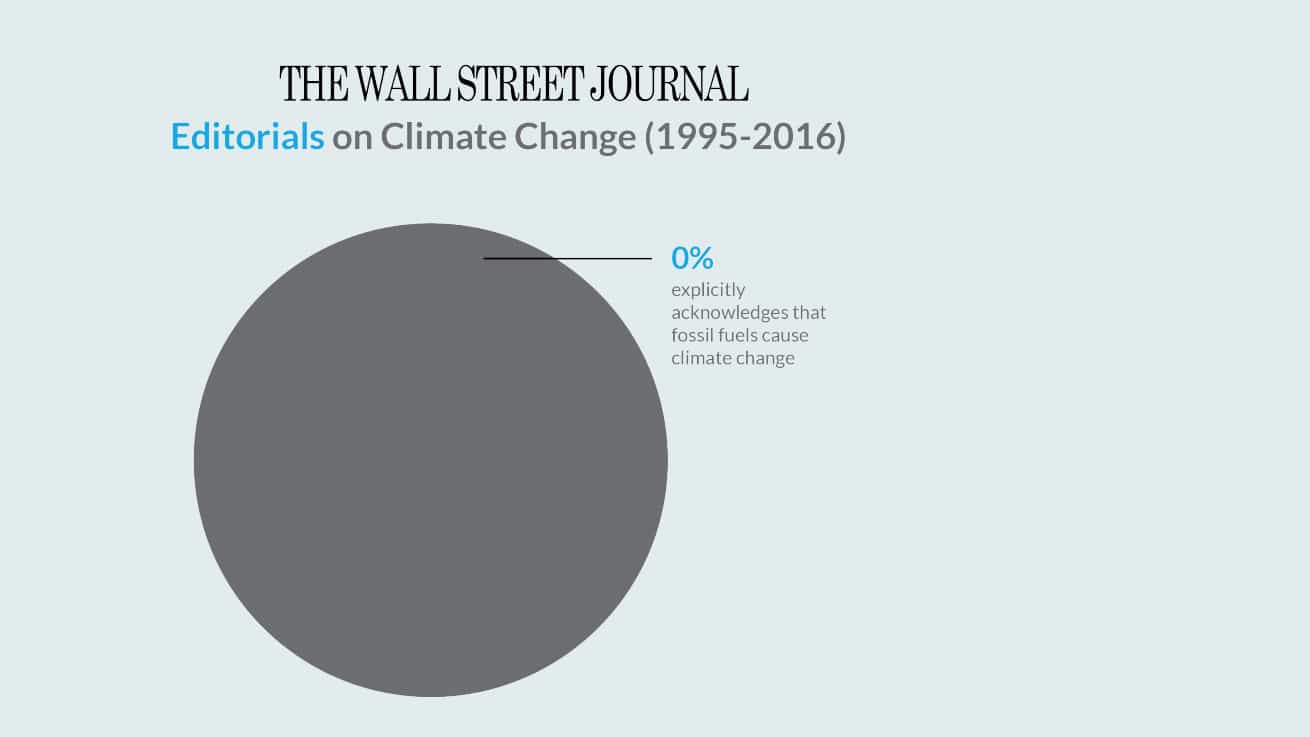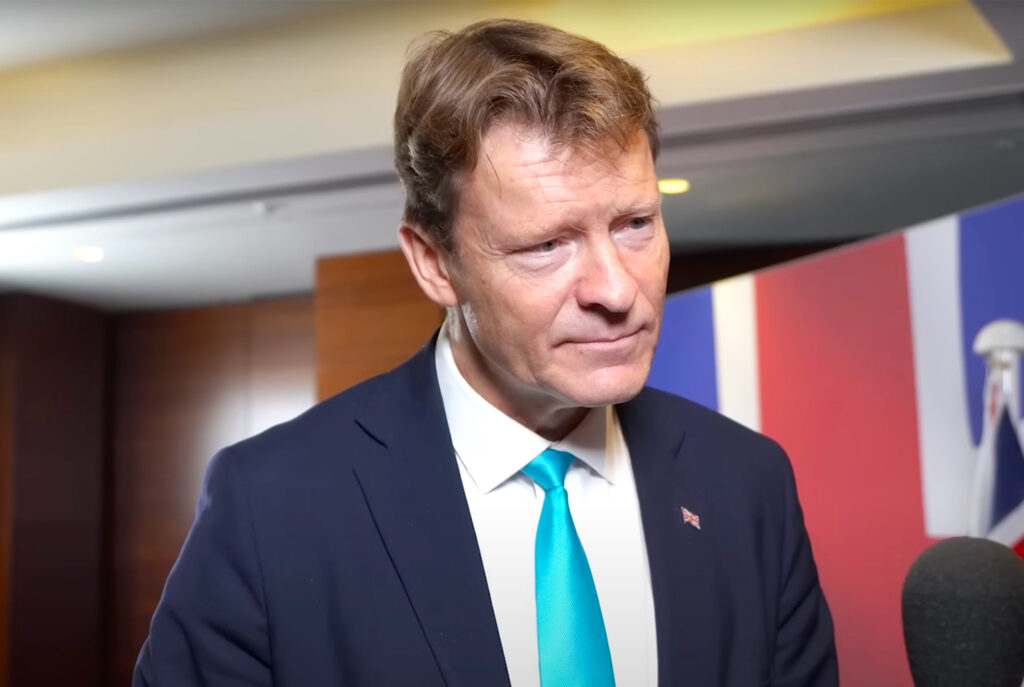The Wall Street Journal has been spiced up substantially recently thanks to a series of adverts on its own pages attacking the paper’s slanted coverage on climate science.
The Washington Post has reported on the background to the advertisements and the group running them — the Partnership for Responsible Growth (PRG).
But basically, it goes like this. PRG analysed a couple of decades of content from the Rupert Murdoch-owned newspaper and found it stunningly out of step with mainstream science, while being remarkably in step with the talking points of fossil fueled climate denialist think tanks and the views of Murdoch himself.
PRG analysed 201 WSJ editorials going back to 1997 and found not a single one of them acknowledged that fossil fuels cause climate change. This is like writing a couple of hundred articles on lung cancer without ever mentioning cigarettes.
The story was largely the same when PRG looked at columns and op-eds published by the paper. Of the 279 op-eds published since 1995, just 40 reflect mainstream climate science, or 14 per cent. Of 122 columns published since 1997, only three per cent accepted as fact that fossil fuels cause climate change, or endorsed a policy to cut emissions.
All up, of the 602 op-eds, columns and editorials published since 1995, just 44 “treat fossil fuel-driven climate change as a reality”, the analysis found.
Ploddingly conventional
Anyway, one of those WSJ columnists — Holman W. Jenkins, Jr — has written a response to the adverts. The column was also printed in another Murdoch-owned paper, The Australian. Jenkins’ contribution is appropriate, given that he says he has written more on the climate issue for the WSJ than anyone else.
Jenkins claims that rather than being out there on the fringes, his views on climate science have been “ploddingly conventional”.
He then goes on to provide just the kind of column that prompted the ads in the first place — one so “ploddingly conventional” among too many right-wing commentators and climate science denialists.
Let’s have a look at just a few of Jenkins’ easily checkable claims.
First, Jenkins says that in its latest report, the United Nations’ Intergovernmental Panel on Climate Change (IPCC) says “a human role accounts for half the warming between 1951 and 2010.” This, Jenkins says, is a statement with less than 100 per cent confidence.
Firstly, the latest IPCC report says it is “extremely likely” that more than half the global surface temperature increase between 1951 and 2010 was caused “by the anthropogenic increase in GHG concentrations and other anthropogenic forcings together”.
But the very next sentence goes on to summarize what this means. The report says: “The best estimate of the human-induced contribution to warming is similar to the observed warming over this period.”
So rather than humans contributing to half the warming, the IPCC actually says humans are probably responsible for all of it (that’s partly because some human influences, such as aerosols from burning fossil fuels, can have a cooling influence).
Jenkins goes on, apparently obsessed about uncertainties in the science without explaining what they really mean. He writes:
I’ve written that it would be astonishing if human activity had no impact, but the important questions are how and how much. The IPCC agrees, estimating that a doubling of atmospheric CO2 from pre-industrial times would hike temperatures between 1.5 degrees and 4.5 degrees Celsius, notably an increase in the range of uncertainty since its last report.
Jenkins is referring to estimates around Equilibrium Climate Sensitivity (ECS) — that is, how much warming you will get if you double atmospheric concentrations of carbon dioxide. The quoted numbers are right, but why is he so excited about the increase in the range of uncertainty from the past report? Is this because it will leave readers thinking scientists are less certain about impacts than before?
What would readers think if, rather, Jenkins had told them this ECS range is almost exactly the same as the major IPCC report from 2001, and the one in 1995?
Doubt over science
Jenkins then tries to claim that “science has been unable to discern signal from noise in the hunt for man-made warming”. This, says Jenkins, is “why the IPCC relies on computer simulations”.
Really? Science can’t discern the human signal from the noise?
Professor Steve Sherwood, of the University of New South Wales Climate Change Research Centre, told me:
“That’s just not true. There are dozens and dozens of studies that have done exactly this. There’s a whole field of climate science looking at detection and attribution. For example, you can see the human fingerprint of greenhouse gas warming in precipitation extremes, in the vertical pattern of change between the stratosphere and troposphere. And all these studies use observations and models. If you are dismissing models, then that means the person does not understand the scientific process.”
Given that Jenkins is apparently so interested in the IPCC, perhaps he should have pointed out to his readers that the report he has been citing has an entire chapter on the detection and attribution of human activity on climate change.
Model attack
Next, Jenkins tries to undermine the importance of climate models — another favourite climate science denialist hobby horse.
“Indeed,” writes Jenkins, “the most telling words in [the IPCC‘s] latest report are a question: “Are climate models getting better, and how would we know?”
Odd that Jenkins would think the question posed in the IPCC report is more important than the answer it gave. And what was the answer?
In short, the IPCC explained models are improving all the time, both in their outputs and in their complexities.
Next, Jenkins says the Obama administration agrees with him that it is difficult to justify action on cost-benefit grounds. He says the Obama administration admits “its coal plans will cost many billions but have no meaningful impact on climate even a century from now.”
There are two things to say about this. Firstly, the Obama administration has clearly articulated the benefits of its Clean Power Plan. The EPA says cutting fossil fuel energy generation will be worth an estimated $55 billion to $93 billion in 2030, compared to annual costs of about $8.8 billion.
Clearly it would be hard for anyone to justify pushing a policy that would save your economy upwards of $40 billion a year!
Secondly, none of this puts a price on the avoidance of up to 6600 premature deaths and 140,000 asthma attacks in kids the EPA says the cuts will deliver — because you can’t put a price on suffering.
Jenkins then reserves some of his blundershot for climate reporters.
Here’s what you also won’t learn from most climate reporting: Climate models that predict significant warming presume natural feedbacks that magnify the impact of human-released carbon dioxide by 100% to 400%. Models that presume no dominant feedbacks see warming of only about one degree Celsius over the entire course of a doubling of atmospheric CO2.
I’m not really sure what Jenkins is getting at here, because surely he can’t be trying to argue that models “should not presume dominant feedbacks”, such as how rising CO2 in the atmosphere leads to an increase in that other key greenhouse gas — water vapour. This would be like trying to explain how a car runs on petrol by ignoring the engine and the wheels.
But I asked Professor Roger Jones, an IPCC veteran based at Melbourne’s Victoria University, if Jenkins has a point.
“Well, if you take out the atmospheric physics then of course the models will give you the answer you want. There are two parts to this that are core. One is the forcing (the carbon dioxide) and that has been known for a long time. Then there are the feedbacks, and those are also well known from many studies.”
Attack on journalists
Jenkins claims that climate reporters also won’t tell you that “models that assume minimal feedback are more consistent with the warming seen so far.” Well, perhaps the reason why experienced climate change reporters won’t tell you this, is because it’s probably wrong!
This is a well-worn trope from climate contrarians who have tried to argue that because some temperature observations appeared to show a slowdown in surface warming in the last 10 to 15 years, that this meant that the models were running too hot.
This ignores studies that have found that when scientists select models that happened to be “in phase” with natural swings in the climate system, such as El Nino, those same models that project high levels of global warming also reproduced the same temperatures seen recently.
These short term fluctuations where models can appear to run slightly too hot, or slightly too cool, is essentially a red herring. Climate models are not designed to predict the weather in 50 years time, but are instead there to present a picture of the world’s general climate.
Now this is complex and nuanced, but given Jenkins seems to want to lecture journalists on how they should do their job, then perhaps he should also consider this.
Just as it is the job of a journalist to ask questions, it’s also our job to protect the public interest by finding the most reliable answers. Part of this means being able to discern expertise.
So when we know that multiple studies have found that more than 90 per cent of climate experts agree that climate change is being caused by us, then the Wall Street Journal’s “ploddingly conventional” position is revealed as anything but.
Subscribe to our newsletter
Stay up to date with DeSmog news and alerts






